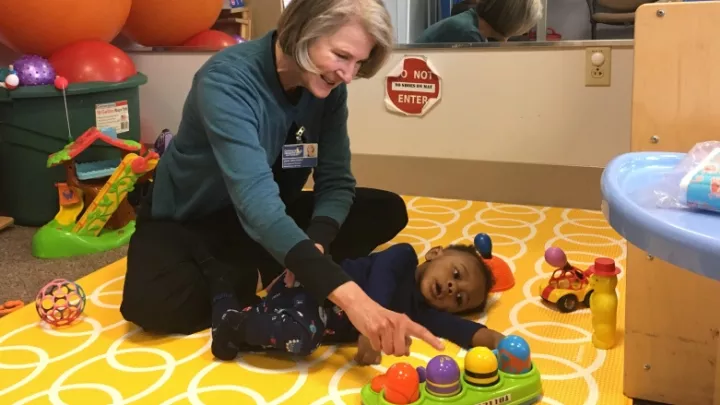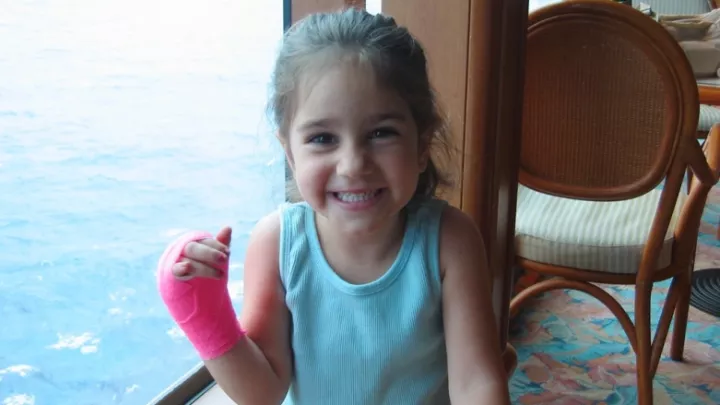
Stella Raises Her Arms in Victory
Until the day her family got a surprise phone call from Mitch Seruya, MD, Heather Murillo had been at a loss.
Murillo’s youngest daughter, Stella Carrillo, had brachial plexus palsy—also called Erb’s palsy—a condition that rendered her unable to use her left arm. The condition occurs when the brachial plexus nerves, which provide movement and feeling to the arm and shoulder, are damaged. In Stella’s case, the injury happened at birth, after her left shoulder got stuck during a complicated delivery.
Despite more than a year of treatment at another hospital, Stella had made no progress. Although she could use her hand, her left arm continued to dangle at her side, limp and seemingly lifeless.
“Honestly, I didn’t know what to do,” Murillo says. “A lot of people were telling me, ‘Just accept it; this is how she’s going to be.’ I did accept it, but I also wanted to see if there was more that I could do, while she was still little enough to get help.”
A race against time
Murillo’s mom, who works as a surgical technician at a Glendale hospital, had long been asking her colleagues if they knew of a brachial plexus specialist to help Stella. One colleague continually recommended a surgeon in Texas: Mitch Seruya.

As luck would have it, in the fall of 2015, Seruya—a pediatric plastic surgeon who specializes in hand and microsurgery—was recruited to come to Children’s Hospital Los Angeles. His Glendale colleague told him about Stella, and one afternoon in November, Seruya called Stella’s grandmother “out of the blue” at work.
The next day, Murillo and her mom brought Stella to see him at CHLA. Seruya knew that time was of the essence.
“Time is nerve,” he explains. “If an injured nerve doesn’t come back over the course of 12 to 18 months, it loses its connection to the muscle, and the muscle is irreversibly lost.”
Traditionally, brachial plexus injuries are treated with nerve graft surgery. But it takes many months for a nerve graft in the neck to grow long enough to connect to its target muscles. Stella was already 14 months old. It was too late for such a surgery.
Seruya, though, offered hope: a newer, innovative approach called nerve transfer surgery. Instead of creating a traditional nerve graft in the neck, nerve transfer surgery takes expendable motor nerves from places like the wrist and connects them right next to the muscles they need to activate.
Because the transferred nerves wouldn’t have to grow much, there was hope that Stella’s shoulder and arm muscles could “turn on” in time. Seruya had had success with nerve transfers in brachial plexus patients before, but Stella would be his oldest patient to date.
‘It’s a miracle’
Murillo and Stella’s dad, Rogelio Carrillo, agreed to try it, and on Jan. 19, 2016, Seruya performed nerve transfer surgery on Stella at CHLA.
Several weeks later, when the cast came off, Murillo and Carrillo couldn’t believe their eyes: Stella could lift her left arm.
Just 10 weeks after her surgery, she scored an amazing 83 percent on an assessment test of her left arm and shoulder. She’d never been able to flex her elbow; today, she brings her bottle and food to her mouth with ease. She can reach her arm high over her head, too. In fact, she now sleeps with both arms raised above her head.

“She has full use of her arm,” Murillo marvels. “Full use! It’s incredible. It’s a miracle.”
Seruya, who has joined CHLA’s multidisciplinary Brachial Plexus Clinic, says
nerve transfer surgery is his preferred technique for brachial plexus injuries like Stella’s. He has already published data from some of his cases, and hopes to publish additional results soon.
“One of the challenges with these injuries is that parents have no idea where to go and what the urgency is, and pediatricians don’t know where to send them,” Seruya explains. “My goal is to spread awareness so patients can get the care they need before it’s too late.”
Stella is now almost 2 and undergoing occupational therapy at CHLA to “remind” her to use her left arm. The happy, energetic toddler gleefully throws balls, pushes her doll stroller—and even reaches up to tables to sneak a cookie.
“Every time I see Dr. Seruya I tell him how grateful we are,” Murillo says. “I really want other parents to know that there’s help for Erb’s palsy. There’s help, and there’s hope.”


